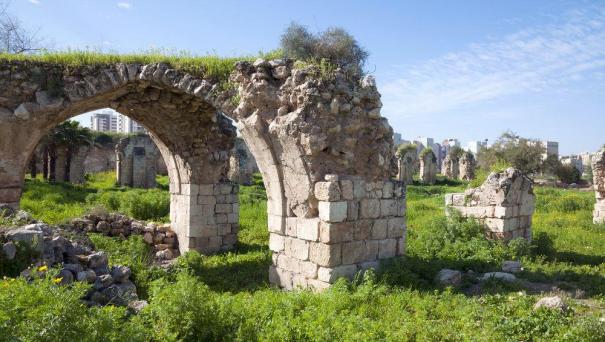 |
| ancient ruins at Ramla, courtesy, pokku/Shutterstock posted in TotallyJewishTravel website |
During the time of Joshua,
the site of Ramla was allotted to the tribe of Dan but the town itself was
founded over two millennia later, in c. 715–717 CE by the Arab Umayyad governor and future caliph Sulayman ibn Abd
al-Malik. It became the only town in Israel founded by Arab Muslims.
Although originally established for Arab Muslims, it had from the beginning a
large population of Christians, Jews, and Samaritans. The increase of the
Samaritan farming population on the outskirts of the town was due to the
efforts of Hārūn al-Rashīd, the Abbasid Caliph in the late eighth century. Since
the 10th century, Ramla often served as a place of refuge for the
ruling geonim from Jerusalem, accompanied by his rabbinical assembly, at times when
intense conflicts would erupt between the rabbinic authorities. At that time, a
Karaite and a Rabbanite community, the latter divided into Palestinians and
Babylonians, existed in the town; there were also synagogues for the Jerusalemites and the Damascenes. Ramla also became
a major transit hub for caravans of Radhanites – Jewish merchants who travelled
in convoy from France to China and back again. In the 11th century
however, the flourishing communities of Ramla suffered from a series of blows:
a disastrous Bedouin raid in 1025 and two devastating earthquakes in 1033 and
1067 (in the latter, 25,000 people reportedly perished). During the Crusader
occupation, beginning in 1099, the Jewish and Samaritan communities were
dispersed. However, some did return and when Rabbi Benjamin of Tudela visited the
area in 1170–71, he recorded “…there are remains
of the walls from the days of our ancestors, for thus it was found written
upon the stones. About 300 Jews dwell there. It was formerly a very great city;
at a distance of two miles there is a large Jewish cemetery." In the remaining years of the Crusader
period, the Jews wandered away once again but by the 14th century,
it was again the largest town in Palestine and a Jewish community was
reestablished there. A tradition reported by Ishtori Haparchi (1280–1355) and other early
Jewish writers is that Ramla was the biblical Gath of the Philistines but initial archaeological claims
seemed to indicate that Ramla was not built on the site of an ancient city, although
in recent years the ruins of an old city were uncovered on the southern
outskirts. According to many scholars, there was a Gath which is believed
to be Tell es-Safi outside of the city limits, and a Gath-rimmon or Gittaim,
believed to be in or near the town itself. With the Ottoman conquest, Ramla once
more declined, although most pilgrims passed through it on their way to
Jerusalem. Throughout the 19th century, Ramla maintained a small
Jewish community – so small, it numbered only 2 families at mid-century,
although there was an intense social interchange with Jaffa throughout this
period. In 1889, 31 Jewish worker families settled in the town.
At the end of the 1920s, Ramla
became connected to wired electricity (supplied by the Zionist-owned Palestine Electric
Company). During the Arab riots in 1929, most of the local Jews were
ethnically cleansed from the town. Those that were left were, as well,
ethnically cleansed during the Arabs riots in 1936. In 1947, when the United
Nations voted to partition Palestine into Jewish and Arab states, Ramla was
awarded to the proposed Arab state, but with the massive Arab assault on the
Jewish state which started the War of Independence, Ramla was taken over by the
Jews. At that time, the town had an Arab majority. Most, but by no means all, fled.
After the war, Ramla was a mixed Jewish-Arab town. Poor Jewish refugees from “Arab”
countries soon settled there. They were later joined by most of the Jewish
community of Karachi, Pakistan. The Karachi Jews ultimately built their own
synagogue named Magen Shalome, after
the original Magain Shalome Synagogue in
Karachi. Ramla also became the center of Karaite Judaism in Israel. In 1963, they
established their own Karaite Synagogue
on Yosef Klausner Street. In the
90s, the town received thousands of immigrants from the former Soviet Union.
From the end of the war
and for the next two decades, Ramla was an economically depressed and crime-ridden
town. It gradually acquired a very negative reputation in the eyes of the
public. Five of Israel's prisons today,
are located in Ramla, including the maximum-security Ayalon Prison and
the country's only women's prison, Neve Tirza.
In recent decades, attempts have been made to develop and beautify the city. New
shopping malls and public parks have been built, and a municipal museum opened
in 2001. The Ramla Museum is housed
in the former municipal headquarters of the British Mandatory authorities. The
building, from 1922, incorporates elements of Arab architecture such as arched
windows and patterned tiled floors. After 1948, it was the central district
office of the Israeli Ministry of
Finance.
During the years of the
"al-Aqsa" Intifada beginning in 2000 a few synagogues were set on
fire and the Jews tried to burn a mosque.
Other sites include: the Commonwealth War Cemetery, largest of its kind
in Israel, holding graves of soldiers fallen during both World Wars and the
British Mandate period; the Giv'on
immigration detention centre; Nesher Israel Cement Enterprises flagship
factory, Israel's sole producer of cement; Ramla Railway Station,
originally opened in April 1891, making it the oldest active railway station in
Israel, rebuilt in 2003; Open House, a preschool
and daycare center for Arab and Jewish children which also runs extracurricular
coexistence programs for Jewish, Christian, and Muslim children.
No comments:
Post a Comment